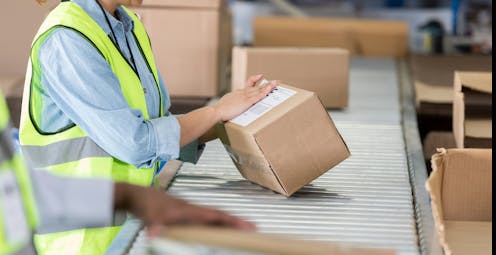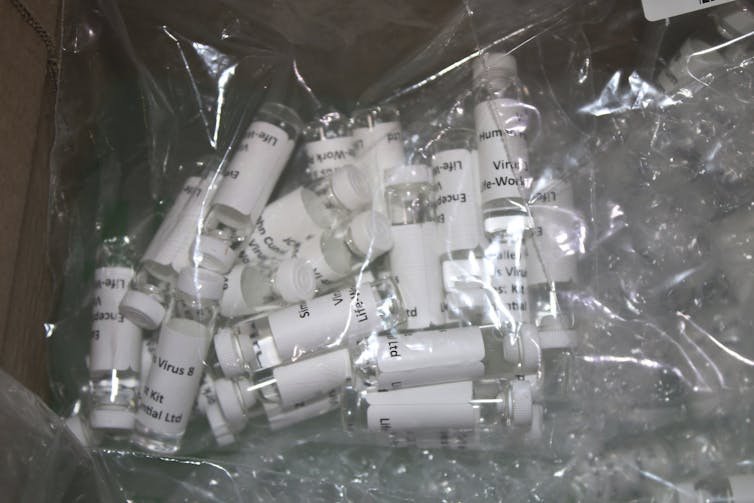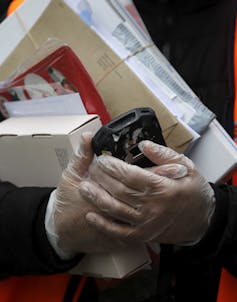Buyer beware: Counterfeit markets can flourish during a public health crisis
The recent seizures of counterfeit testing kits by U.S. Customs and Border Protection show that the counterfeiters have begun to take advantage of the coronavirus crisis.

Rapid acceleration of coronavirus-related infections and fatalities in countries like Italy, Spain and the United States has led to widespread bans on communal activities, global restrictions on travel and an increasing reliance on virtual interactions.
The push to keep people indoors has lead to a substantial increase in e-commerce and internet-based activities, including video streaming, grocery shopping, food delivery and education. People are becoming increasingly reliant upon these services to provide life’s basic necessities – and counterfeiters are primed to take advantage of this unique opportunity.
Counterfeiters have long preyed upon consumer vulnerability in order to make a quick profit. The current coronavirus crisis will likely be no different. However, what is unique about the current crisis is the extent to which consumers are relying upon e-commerce platforms.
Crisis drives demand
The recent seizures of counterfeit testing kits by U.S. Customs and Border Protection at LAX and Chicago’s O’Hare airport are proof that the counterfeiters have begun to take advantage of this crisis. These seizures are a stark reminder that counterfeiters will prey upon vulnerable populations wherever they may be.
Prior public health crises can provide clues as to what can be expected from the current crisis. For example, during the Ebola crisis, there was no vaccine available to treat infected patients, so health care providers focused on treating the symptoms and related infections that came along with the disease. Counterfeiters worked hard to get fake versions of common medications into the legitimate supply chain, as demand for these goods rose.
Once targeted therapies for Ebola were developed, demand for these commonly used medications fell away, and counterfeiters shifted to producing fake versions of the new treatments. Counterfeit medicines took the place of legitimate medicines that would have been used to treat people with the disease.
As a scholar who has been immersed in the study of product counterfeiting for the past five years, I expect to see a similar pattern with the current coronavirus crisis. Counterfeiters will put their efforts into flooding the market with products that are in demand until specific coronavirus treatments are developed, at which point they will shift to producing counterfeits of those treatments.

Risks of e-commerce
Before the coronavirus crisis began, e-commerce services were already under heavy scrutiny from U.S. lawmakers for their lack of action regarding counterfeit products, ranging from jewelry and footwear to cellphones and electronics.
The current threat creates a potentially dangerous situation, as consumers seeking products that are in demand yet scarcely available, like hand sanitizer and face masks, may turn to the very venues that are most used by counterfeiters to dupe the unsuspecting public. Sites like Amazon, Walmart Marketplace and Wish.com have all experienced serious problems with counterfeit products.
Crisis-driven consumer demand, mixed with waning product inventories and an increasing reliance upon internet-based commerce, creates ideal conditions for product counterfeiting. Yet, in my view, the most dangerous aspect of the current crisis is consumers’ inability to reliably distinguish genuine goods from fake products.
Consumers sometimes have a good ability to identify counterfeit logos when the legitimate brand is well-recognized and the fake logo contains easily identifiable errors. For example, differences in the color or placement of a brand’s logo are one of the most prominent clues that an item is fake.
However, counterfeiters that operate on e-commerce platforms have become very adept at producing authentic-looking packaging and logos.
Furthermore, when it comes to testing kits and other coronavirus-related products that are yet to be developed, consumers have no frame of reference upon which they can rely when attempting to determine an item’s legitimacy. That makes it more likely that counterfeit products will proliferate throughout the marketplace during the current crisis.
For example, take at-home coronavirus testing kits. Many journalists and consumers see at-home testing kits as an ideal means to tackle the disease more quickly and fill the current gap in hospital-based tests.
However, the U.S. Food and Drug Administration has stated clearly that none of these tests has been approved for use. Therefore, any tests consumers see advertised are unapproved.
Be alert

While the current crisis presents many new and substantial challenges, it also affords consumers the opportunity to be vigilant in mitigating risks.
For example, consumers should verify the sellers of products found online before making purchases. Sites like Amazon and Walmart Marketplace cater to third parties looking to sell products to consumers. Counterfeiters can take advantage of the anonymity afforded by e-commerce platforms.
Be sure to verify that the brand you are looking to buy actually sells their products on the site; then verify that the entity advertising the product is the company that actually makes the product.
To aid in this process, brands can inform consumers about how to buy legitimate products by creating direct links from their official corporate pages to their official e-commerce sites. For companies that sell through distribution, it is essential that they maintain a list of approved vendors, which I would highly recommend they publish in a way that is easily accessible to consumers.
Now, more than any time in the recent past, the global health risks of counterfeit goods are clear and present. They should prompt governments, businesses and consumers to be vigilant.
[You’re smart and curious about the world. So are The Conversation’s authors and editors. You can read us daily by subscribing to our newsletter.]
Jay Kennedy does not work for, consult, own shares in or receive funding from any company or organization that would benefit from this article, and has disclosed no relevant affiliations beyond their academic appointment.
Read These Next
As DOJ begins to release Epstein files, his many victims deserve more attention than the powerful me
Powerful men connected to Jeffrey Epstein are named, dissected and speculated about. The survivors,…
The world risks forgetting one of humanity’s greatest triumphs as polio nears global eradication − 7
Polio may finally be defeated in the next 5 years. Will the world recognize what an extraordinary achievement…
People are getting their news from AI – and it’s altering their views
Even when information is factually accurate, how it’s presented can introduce subtle biases. As large…






